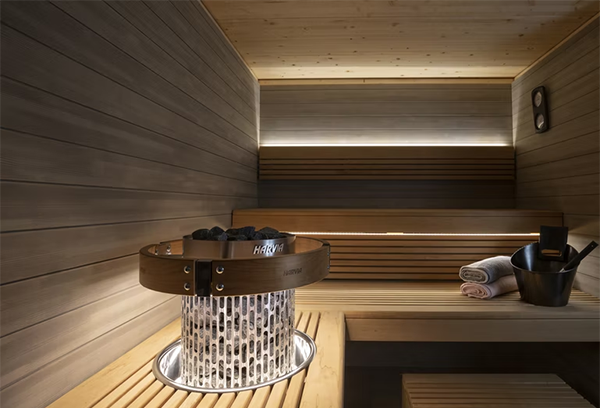Walls are one of the main building components of a sauna. Proper insulation is crucial to retaining heat and humidity, creating an efficient and enjoyable sauna experience. In this article, we'll discuss everything you need to know about sauna insulation in depth.
Understanding Sauna Insulation Needs
Saunas pose unique construction challenges due to their high temperatures, reaching up to 248°F, and high humidity levels when water is thrown on the rocks. To retain heat and humidity, you have two main options: using thick solid timber logs or creating a ‘sandwich’ of insulation and membranes within a timber frame wall. As an architect, I recommend the latter for several reasons:
-
Efficiency in Material Use: Limits the amount of wood required.
-
Superior Thermal Performance: Provides better U and R values than solid log constructions of the same thickness.
-
Space Saving: Allows for thinner walls, conserving space.
Sauna Wall Vapor Barrier
To effectively retain moisture, a non-breathable vapor barrier is essential. Aluminum vapor barriers are ideal because aluminum melts at higher temperatures, avoiding harmful off-gases. The best choice is a paper-backed aluminum barrier, which offers additional support and reflects radiant heat back into the sauna, contributing to energy efficiency. Ensure you tape all seams to prevent humidity from entering the wall cavity, as damp insulation loses its thermal properties.

Insulation Materials for Sauna Walls
Choosing the right insulation material is crucial for maintaining heat within your sauna. Here’s a breakdown of various options:
-
Mineral Wool (Fiber):
-
Pros: High melting point (~2150°F or 1177°C), relatively inexpensive, semi-rigid boards for easy installation.
-
Performance: A 4-inch (100mm) layer with a K value of 0.035 provides an R value of 2.8, sufficient for an outdoor sauna.
-
Cellulose:
-
Pros: Environmentally friendly, made from recycled paper and wood fibers.
-
Cons: Loses insulating properties when moist, relatively fire-resistant due to added sodium.
-
Straw Bales:
-
Pros: Low CO2 footprint, relatively cheap.
-
Cons: Difficult to find suppliers or contractors experienced with this material.
-
Hemp:
-
Pros: Natural insulating material.
-
Cons: Prone to moisture retention, requiring well-sealed vapor barriers.
-
Natural Fibers (Cotton, Wool):
-
Pros: Non-irritant, comes in rolls or batts.
-
Cons: More expensive than other options like mineral wool or fiberglass.
Not Recommended Insulation Materials
-
Polyurethane:
-
Cons: Contains potentially harmful blowing agents and flame retardants.
-
Polyisocyanurate (PIR):
-
Cons: Releases high levels of toxic products when burned, as per a 2011 study at the University of Central Lancashire Centre for Fire and Hazard Science.

Insulating Sauna Walls: Step-by-Step
Step 1: Prepare the Walls
- Frame the sauna walls and ceiling, ensuring even spacing for insulation placement.
Step 2: Install Insulation
- Cut insulation to fit snugly between the studs. For materials like mineral wool, wear protective gear to prevent irritation.
Step 3: Apply Vapor Barrier
- Cover the insulation with a paper-backed aluminum vapor barrier. Ensure all seams are taped to prevent moisture ingress.
Step 4: Install Interior Cladding
- Add heat-resistant wood cladding (like cedar or thermo-aspen) on the interior, which protects the insulation and enhances the sauna’s aesthetic.
Calculating Thermal Performance
K Value: Indicates a material's ability to conduct heat. Lower values are better for insulation. R Value: Represents thermal resistance. Calculated as R = Thickness / K Value. U Value: Measures overall heat loss. Lower U values indicate better insulation performance.
Benefits of Proper Sauna Insulation
-
Energy Efficiency: Reduces heating costs by retaining heat more effectively.
-
Comfort: Ensures a stable, comfortable temperature during use.
-
Durability: Protects structural integrity by preventing moisture damage.
-
Quick Heating: Allows the sauna to reach desired temperatures faster.
FAQs about Sauna Wall Insulation
Q: Can I use regular home insulation for my sauna? A: It's best to use insulation materials designed for high-heat environments to ensure safety and efficiency.
Q: How thick should sauna insulation be? A: 4 inches of mineral wool is generally sufficient. For colder climates, consider 6 inches.
Q: Do I need to insulate the sauna floor? A: Floor insulation can enhance heat retention, especially in colder regions, but it's not always necessary.
Wrapping It Up
Insulating your sauna walls properly is essential for an efficient and enjoyable experience. By choosing the right materials and following best practices, you can create a sauna that is both energy-efficient and comfortable. For optimal performance, use a 4 inches mineral wool rigid board and a high-quality aluminum vapor barrier with taped seams.
Want us to design your entire sauna for free (and provide all the materials)?









Leave a comment